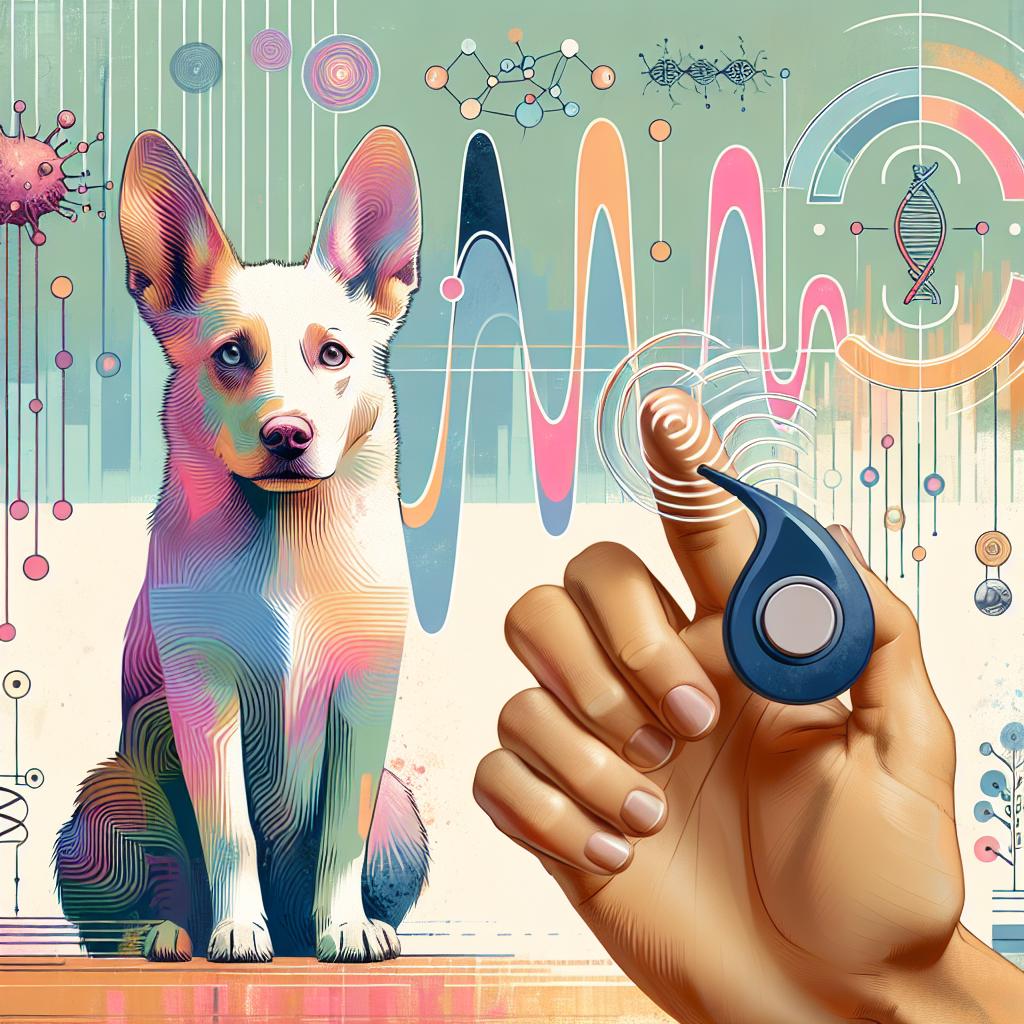Unlocking the Secrets: The Science Behind Clicker Training for Dogs
In a world where interaction often transcends words, the bond between humans and their canine companions thrives on mutual understanding. Enter clicker training—a technique that has captivated dog owners and trainers alike,promising enhanced interaction and effective learning. But what lies beneath the simple click of a device? It’s more than just a sound; it’s a gateway to behavioral mastery rooted in psychological principles. This article delves into the intriguing science behind clicker training, exploring how this methodology leverages the laws of operant conditioning to foster remarkable learning experiences for dogs. Join us as we unravel the mechanics of this method, illuminated by research and real-world application, to understand why this seemingly simple tool has become a cornerstone in the training of our four-legged friends.
Understanding Operant Conditioning in Clicker Training
Operant conditioning is a basic principle in behaviour modification, and it plays a critical role in clicker training. This technique relies on the concepts of reinforcement and punishment to shape a dog’s behavior over time. The clicker serves as a bridge between the desired action and it’s reward, allowing the dog to associate the sound of the click with positive outcomes.When used consistently, the clicker can turn simple commands into cues that the dog eagerly responds to. The process can be summarized with these key elements:
- Positive Reinforcement: The dog is rewarded for exhibiting the desired behavior, encouraging repetition.
- Timing: The click must occur promptly after the behavior to create a clear connection.
- Consistency: Using the clicker consistently reinforces learning and builds the dog’s confidence.
This approach not only enhances communication between the owner and the dog but also fosters a positive training environment. Furthermore, the effect of operant conditioning can be illustrated through a simple table summarizing the different types of operant conditioning and their effects on behavior:
| Type of Conditioning | Effect on Behavior |
|---|---|
| Positive Reinforcement | Increases desired behavior |
| Negative Reinforcement | Encourages behavior by removing an aversive stimulus |
| Positive Punishment | Decreases unwanted behavior through added unpleasant consequences |
| Negative Punishment | Decreases unwanted behavior by removing a pleasant stimulus |

The Role of Timing in Effective Clicker Training
Timing plays a crucial role in clicker training, as it directly influences how effectively a dog associates a behavior with its reward. The clicker sound serves as a bridge between the action performed by the dog and the subsequent treat, making it essential for trainers to mark the behavior at the precise moment it occurs. immediate reinforcement not only solidifies this connection but also enhances the dog’s understanding of what behavior is being rewarded. If there is a delay, the dog may become confused, associating the click with something other than the intended action, which can slow or hinder the training process.
To achieve optimal timing,trainers can follow some practical tips:
- Stay Focused: Minimize distractions in the training environment to allow for swift reactions.
- Practice Click Timing: Use a friend or a mirror to practice clicking at the right instant while observing behaviors.
- Keep Sessions Short: Short and frequent sessions help maintain focus and provide clear opportunities for timely clicks.
By mastering the art of timing, trainers can significantly improve their effectiveness in creating a positive learning experience for their dogs. Below is a simple table illustrating the importance of timing in clicker training:
| Timing | effect on Training |
|---|---|
| instant Click | Strengthens behavior association |
| Delayed Click | Creates confusion; weakens association |
| Consistent timing | Promotes reliability and understanding |

Choosing the Right Clicker and Treats for Success
When selecting a clicker for training your dog, there are a few vital factors to consider. Ergonomics is key; a clicker should feel agreeable in your hand, allowing for speedy and efficient use. Look for models that are easy to press and provide a clear, distinct sound. Many trainers prefer models that have a wrist strap for added convenience. Additionally, some clickers come with built-in features such as volume control or lights, which can add versatility to your training sessions. Most importantly, choose a clicker that suits both you and your dog’s personality—some dogs may respond better to specific sounds.
Equally crucial is the selection of treats to accompany your clicker training. High-value treats will motivate your dog to engage and respond positively. Consider the following options when choosing treats:
- Paw-some Pecks: Small training treats or bite-sized kibble
- Meaty Morsels: Cooked chicken or turkey cut into tiny pieces
- Cheesy Delights: Soft cheese or cheese-flavored snacks
- Fishy Favors: Freeze-dried fish bits for an aromatic touch
- Homemade goodness: treats made from oats and peanut butter
Remember to balance the calories in treats with your pet’s daily food intake to maintain their health. The ideal treats should be small,soft,and easy to chew,allowing for rapid consumption so training can progress smoothly.

Common Challenges and Solutions in Clicker Training
Engaging in clicker training can bring about various challenges for both trainers and their furry companions. One of the most common hurdles is the dog’s inconsistent response to the clicker. Sometimes,dogs might not associate the sound with the reward due to distractions or lack of clarity in cues. To address this, create a controlled training environment, minimizing outside distractions. Reinforce the connection between the click sound and treats by practicing in short sessions and gradually increasing the complexity of tasks as your dog becomes more responsive.
Another frequent challenge is timing. Inadequate timing can lead to confusion, as it’s essential for the click to coincide precisely with the desired behavior. If the timing is off,dogs may not understand what action is being rewarded. Trainers can improve this by practicing their clicking skills with a partner or using a clicker app to simulate the sound. additionally, maintain consistent and clear commands to strengthen the understanding of behaviors. Here’s a simple table highlighting some common challenges and effective solutions:
| challenge | Solution |
|---|---|
| Inconsistent responses | Train in a distraction-free environment; keep sessions short. |
| Poor timing | Practice clicking skills; use a clicker app for accuracy. |
| Lack of motivation | Use high-value treats; vary rewards to maintain interest. |
| Confusion with commands | Use clear, consistent cues; practice one command at a time. |
Q&A
Q&A: The Science Behind Clicker Training for Dogs
Q: What is clicker training, and how does it work?
A: Clicker training is a positive reinforcement technique that uses a small handheld device called a clicker to mark desired behaviors in dogs. When a dog performs the desired action, the trainer clicks the device, which creates a distinct sound. This sound is then followed by a reward—typically a treat or praise. The click serves as a clear communication signal that indicates to the dog exactly what behavior is being rewarded, creating a strong association between the action and the reward.
Q: Why is the clicker sound effective for training?
A: The clicker sound is effective because it is a clear, consistent, and unique signal that stands out from the everyday noises in a dog’s environment. Unlike verbal commands,which can vary in tone and volume,the clicker provides a precise and instant indication of correct behavior. This immediacy helps dogs understand which action earned them the reward, enhancing the learning process.
Q: What role does timing play in clicker training?
A: Timing is crucial in clicker training. The click must occur at the exact moment the desired behavior is performed to create a strong association between the action and the reward. Delayed clicking can confuse the dog, resulting in them associating the click with the wrong behavior.This precision in timing helps dogs learn more quickly and effectively.
Q: Does clicker training work for all dog breeds and ages?
A: Yes,clicker training is a versatile method that can work for all breeds and ages. Whether you have a puppy learning basic commands or an older dog needing to unlearn undesirable habits, clicker training can be adapted to suit the individual dog’s learning style. The key is to remain patient and to adjust the training pace based on the dog’s responses.
Q: What are the benefits of clicker training compared to other training methods?
A: Clicker training stands out due to its emphasis on positive reinforcement rather than punishment.This approach helps build trust and strengthens the bond between the dog and the trainer. Clicker training also encourages dogs to think and problem-solve,which can enhance their learning experiences. Additionally, the clear communication provided by the clicker reduces frustration for both the trainer and the dog, leading to more effective and enjoyable training sessions.
Q: Can clicker training help modify unwanted behaviors?
A: Absolutely! clicker training can be used to modify unwanted behaviors by reinforcing appropriate alternatives. As a notable example, if a dog jumps on guests, the trainer can click and reward the dog for sitting calmly rather. Over time, the dog learns to associate the desired behavior—sitting quietly—with positive outcomes, which can help reduce the likelihood of the undesired behavior.
Q: How critically important are consistency and patience in clicker training?
A: consistency and patience are paramount in clicker training. Using the clicker consistently, rewarding promptly, and maintaining a uniform approach to commands and signals helps reinforce learning.Patience is equally critically important; some dogs may learn faster than others, and it’s essential to give them the time they need to grasp new concepts without causing frustration or stress.
Q: Are there any drawbacks to clicker training?
A: While clicker training is highly effective, it may not be suitable for every dog or trainer. Some dogs might be intimidated by the clicker sound, while others may be less motivated by treats. Additionally, clicker training does require a commitment to carrying the clicker and treats during training sessions. Adjusting the method to fit the dog’s personality and finding alternative motivators, such as toys or playtime, can help address these issues.
Q: Can clicker training be used in conjunction with other training techniques?
A: Certainly! Clicker training can complement other training methods, such as leash training or obedience classes. Many trainers incorporate clicker training into their techniques to enhance positive reinforcement and communication. The key is to maintain a cohesive approach that aligns with the dog’s learning style and the trainer’s objectives.
Q: Where can dog owners learn more about clicker training?
A: Dog owners can learn about clicker training through a variety of resources,including books,online courses,Training workshops,and professional dog trainers. Many community centers and local pet stores also offer classes focused on positive reinforcement techniques. Engaging with experienced trainers and other dog owners can provide valuable insights and support as you embark on your clicker training journey.
Concluding Remarks
the science behind clicker training for dogs reveals a fascinating interplay of behavioral principles and canine psychology. As we’ve explored, this method harnesses the power of positive reinforcement, paving the way for effective communication and enhanced learning between you and your furry companion. Whether you’re teaching basic commands or tackling more complex behaviors, the clicker serves as a clear signal—a bridge between intention and action.As you embark on your training journey, remember that patience, consistency, and understanding are key elements in the process. Your dog is not just a pet; they are an eager learner, ready to connect and engage with you through this innovative approach. By employing clicker training, you’re not just facilitating obedience; you’re nurturing a deeper bond built on trust and cooperation.
So, grab that clicker, and let the adventures of learning begin! With every click, you’re building a foundation of knowledge and companionship that will last a lifetime.

